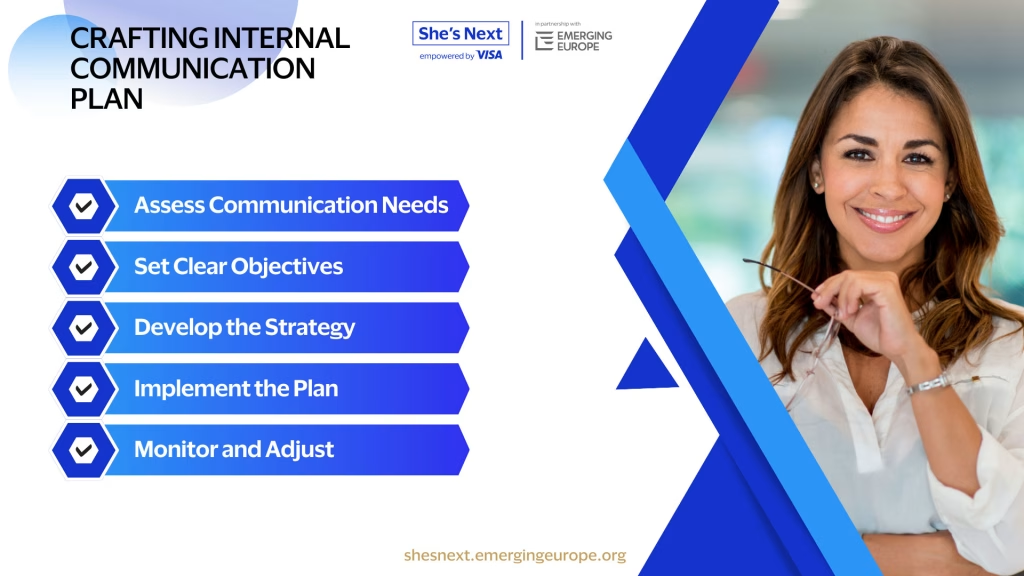
Streamlining Success: Crafting an Effective Internal Communication Plan
Effective internal communication is the backbone of a thriving, engaged, and informed workforce. By fostering open channels of communication, organisations can boost productivity, improve employee morale, and increase job satisfaction.
This guide will outline how to craft a communication plan that drives success across your organisation.
Assessing Communication Needs
Identify the Audience
To create an effective communication strategy, it’s essential to understand the audience you’re communicating with. Segment your internal audience by departments, roles, or levels of seniority to tailor your communication strategies appropriately.
For example, information shared with senior leadership may require a different tone and depth than updates shared with entry-level staff. By recognising these differences, you can ensure that the message is relevant and resonates with the intended audience.
Current Communication Evaluation
Before designing a new communication plan, assess the effectiveness of your existing channels and practices. Methods such as employee surveys, one-on-one interviews, or evaluating current channel engagement (e.g., email open rates or intranet usage) can provide valuable insights into how well your current communication strategy is performing.
For instance, if feedback reveals that emails are often overlooked, it might be time to explore new platforms like a company-wide intranet or instant messaging tools like Slack.
Setting Clear Objectives
Define Goals
Setting specific and measurable objectives is critical to the success of any communication plan. Establishing clear goals makes it easier to define what success looks like.
For example, your communication goal could be ‘improving employee engagement by 10% within six months’ or ‘ensuring that 90% of employees understand new policy changes within the first quarter’. Defining such objectives will provide focus and direction for your communication efforts.
Align with Business Goals
Internal communication should not exist in a vacuum; it must support the organisation’s broader objectives. Ensure that the goals of your communication plan are aligned with your business strategy.
For instance, if the company is going through a digital transformation, your communication efforts should focus on ensuring that employees understand the changes, why they’re happening, and how they will be impacted. Aligning communication with organisational goals ensures that everyone is working toward the same outcomes.
Developing the Communication Strategy
Choosing the Right Channels
Selecting the right communication channels is vital for ensuring that your messages reach the intended audience effectively. Different channels work best for different types of messages.
For instance, policy changes or company-wide updates might be best shared through formal emails or the company intranet. In contrast, social events or quick team updates could be more suitable for instant messaging platforms like Microsoft Teams.
Evaluating the appropriateness of each channel for the type of message ensures that the right people receive the right information in the best way possible.

Creating a Content Plan
Once you’ve identified the channels, the next step is planning the content. Your content plan should outline what type of information will be communicated (e.g., operational updates, policy changes, organisational achievements) and how often.
For example, operational updates might be shared weekly, while major policy changes should be communicated immediately. Consistency is key, so establish a schedule that ensures regular and predictable communication across the organisation.
Implementing the Plan
Rollout Strategy
Rolling out a new internal communication plan should be done methodically. Begin with a pilot test in a specific department or group to identify any potential issues before scaling the plan company-wide.
Once tested, ensure a smooth full-scale implementation by informing all employees of the new communication approach, explaining how it works, and providing guidelines on how to engage with it. For instance, introduce the plan during a company meeting or through a detailed internal memo that explains the upcoming changes.
Feedback Mechanisms
Successful communication is a two-way street. Integrate feedback mechanisms such as suggestion boxes, online forms, or regular pulse surveys to gauge how employees are receiving and participating in the communication plan.
For example, after the first few months of the new plan, you might conduct a quick survey to understand if employees feel better informed and engaged, or if there are aspects that need improvement.
Monitoring and Adjusting
Evaluating Effectiveness
Regularly assess the impact of your communication efforts. Metrics such as employee survey responses, participation in feedback mechanisms, and channel usage statistics can provide insights into how effective the plan is.
For example, if you introduced a new company intranet, monitor how frequently employees log in and engage with the content to assess its impact on information dissemination.
Continuous Improvement
Communication needs evolve, so it’s essential to maintain a cycle of ongoing assessment and refinement. The PDCA cycle (Plan-Do-Check-Act) can be used to ensure your communication plan remains effective.
As your organisation grows or changes, the communication strategy should be adjusted to reflect new needs, technologies, or feedback. Regular check-ins and updates will keep your communication relevant and efficient.
Internal communication is not a one-off task but an ongoing process that evolves with the organisation. By continuously refining your communication plan and adapting it to meet the changing needs of your employees and the business, you can foster a more engaged and informed workforce.
Start by assessing your current strategy and build a communication plan that leads to long-term success.
New Free Courses — Made for Ambitious Women Entrepreneurs!
It’s time to grow smarter, adapt faster, and take your business global.
Explore two powerful courses available exclusively to She’s Next members:
The Reinvention Masterclass for Start-up Founders
Beyond Borders: Building for Global Success
Enroll today — it’s free!





